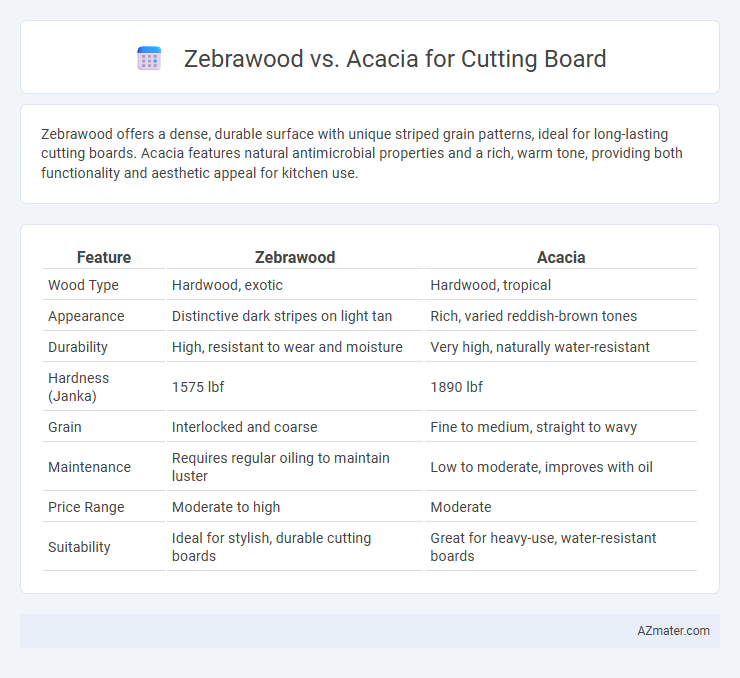Zebrawood offers a dense, durable surface with unique striped grain patterns, ideal for long-lasting cutting boards. Acacia features natural antimicrobial properties and a rich, warm tone, providing both functionality and aesthetic appeal for kitchen use.
Table of Comparison
| Feature | Zebrawood | Acacia |
|---|---|---|
| Wood Type | Hardwood, exotic | Hardwood, tropical |
| Appearance | Distinctive dark stripes on light tan | Rich, varied reddish-brown tones |
| Durability | High, resistant to wear and moisture | Very high, naturally water-resistant |
| Hardness (Janka) | 1575 lbf | 1890 lbf |
| Grain | Interlocked and coarse | Fine to medium, straight to wavy |
| Maintenance | Requires regular oiling to maintain luster | Low to moderate, improves with oil |
| Price Range | Moderate to high | Moderate |
| Suitability | Ideal for stylish, durable cutting boards | Great for heavy-use, water-resistant boards |
Introduction: Comparing Zebrawood and Acacia Cutting Boards
Zebrawood cutting boards showcase a striking grain pattern with exceptional hardness and natural resistance to moisture, making them durable and visually appealing for kitchen use. Acacia cutting boards feature a rich, warm tone and dense fiber structure that provides excellent knife edge retention and resistance to cracking or warping over time. Both woods offer sustainable harvesting benefits, but Zebrawood's unique aesthetics contrast with Acacia's versatility and slightly softer feel under cutting pressure.
Wood Origin and Botanical Background
Zebrawood, derived primarily from the Microberlinia brazzavillensis tree native to West Africa, is known for its distinctive striped grain and dense hardwood properties. Acacia originates from the Acacia genus, encompassing over 1,000 species primarily found in Australia, Africa, and Asia, with Acacia wood prized for its durability and natural antimicrobial qualities. Both woods offer unique botanical backgrounds influencing their hardness, grain patterns, and suitability for cutting boards.
Visual Appearance and Grain Patterns
Zebrawood cutting boards showcase striking, contrasting dark brown and creamy yellow stripes that create a bold, exotic visual appeal. Acacia boards feature rich, warm tones ranging from golden brown to deep reddish-brown with varied, swirling grain patterns that add natural elegance and depth. Both woods offer unique aesthetic qualities, but Zebrawood stands out for its dramatic striping while Acacia presents a more uniform, earthy texture.
Hardness and Durability
Zebrawood, rated around 1570 on the Janka hardness scale, offers exceptional hardness and resistance to dents and scratches, making it highly durable for cutting boards. Acacia, with a Janka hardness of approximately 1700, is slightly harder and provides excellent durability combined with natural antibacterial properties, ideal for kitchen use. Both woods resist moisture and wear well, but Acacia's superior hardness and density often result in a longer-lasting, more resilient cutting surface.
Maintenance and Care Requirements
Zebrawood cutting boards require regular oiling with mineral oil to prevent drying and cracking due to their open grain structure, while Acacia boards benefit from oiling but are typically more resistant to moisture and warping because of their dense, tight grain. Both woods need hand washing and immediate drying to maintain durability, but Zebrawood may demand more frequent maintenance to preserve its appearance. Avoid soaking or dishwasher use for either wood to extend the cutting board's lifespan and prevent damage.
Food Safety and Natural Antimicrobial Properties
Zebrawood and Acacia both offer unique benefits for cutting boards, with Acacia being renowned for its superior natural antimicrobial properties that inhibit bacterial growth, enhancing food safety. Zebrawood, while visually striking with its contrasting grain patterns, is less studied for antimicrobial efficacy but remains durable and resistant to moisture. Choosing Acacia cutting boards provides a safer surface for food preparation due to its dense grain and natural resistance to pathogens, making it a preferred option in kitchens prioritizing hygiene.
Resistance to Moisture and Warping
Zebrawood offers moderate resistance to moisture but is prone to warping if not properly sealed, making it suitable for cutting boards with regular maintenance. Acacia exhibits superior moisture resistance due to its dense, oily grain structure, reducing the risk of warping and extending the board's lifespan in wet conditions. Both woods require sealing, but Acacia's natural durability makes it a preferred choice for cutting boards exposed to frequent washing and moisture.
Price and Availability
Zebrawood cutting boards typically cost more due to their exotic nature and limited availability, often ranging between $80 to $150. Acacia offers a more budget-friendly option, with prices generally between $30 and $70, benefiting from wider availability and sustainable harvesting practices. Both woods provide durability, but Acacia's accessibility makes it a popular choice for affordable, quality cutting boards.
Environmental Impact and Sustainability
Zebrawood is often sourced from West African rainforests, where logging practices can contribute to deforestation and habitat loss, raising concerns about its sustainability. Acacia, especially when harvested from managed plantations or regrowth areas in Australia and Africa, tends to have a lower environmental footprint due to faster growth rates and renewable harvesting practices. Choosing sustainably certified acacia cutting boards supports responsible forestry and reduces ecological impact compared to zebrawood alternatives.
Which is Better for Your Kitchen: Zebrawood or Acacia?
Zebrawood offers striking visual appeal with its bold striped grain and high density, making it highly resistant to knife marks and moisture, ideal for long-lasting cutting boards. Acacia provides excellent durability and natural antimicrobial properties, along with a warm, rich color that enhances kitchen aesthetics. For kitchen use, choose Zebrawood for superior hardness and unique appearance, while Acacia is better for budget-friendly, sustainable options with solid performance.

Infographic: Zebrawood vs Acacia for Cutting Board
 azmater.com
azmater.com